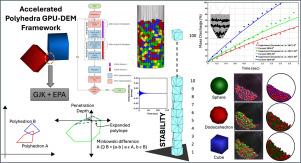GPU based discrete element modeling for convex polyhedral shape particles: Development and validation
IF 4.5
2区 工程技术
Q2 ENGINEERING, CHEMICAL
引用次数: 0
Abstract
Particle dynamics simulations face a significant challenge in understanding the intricate behaviors of convex polyhedral particles due to their complex geometries and interactions. DEM emerges as a key method, illuminating the concealed intricacies of these geometric entities. Traditional algorithms often require cumbersome processes to check each type of contact individually. However, Gilbert–Johnson–Keerthi’s (GJK) and the expanding polytope algorithm (EPA) provide efficient numerical solutions for polyhedral contact detection and contact resolution. These Minkowski difference-based methods streamline contact detection and overlap computation, paving the way for deeper exploration of three-dimensional contact theory within DEM simulations. By leveraging GPU computational power, this paper outlines key algorithmic steps and verifies the solver’s accuracy through comparison with simulated and experimental data, with an average deviation of less than 5%. This study explores the impact of particle shape on the dynamics and mechanical behavior of densely packed systems, particularly in hoppers and tumblers. Spherical particles discharge faster but mix more slowly than polyhedral shapes, with icosahedrons achieving quicker full mixing. These results align with experimental findings, further validating the simulation approach.

基于 GPU 的凸多面体形状粒子离散元素建模:开发与验证
由于凸多面体粒子的几何结构和相互作用十分复杂,要了解它们错综复杂的行为,粒子动力学模拟面临着巨大的挑战。DEM 是一种关键方法,它能揭示这些几何实体隐藏的复杂性。传统算法通常需要对每种接触类型进行单独检查,过程繁琐。然而,Gilbert-Johnson-Keerthi(GJK)和扩展多面体算法(EPA)为多面体接触检测和接触解析提供了高效的数值解决方案。这些基于闵科夫斯基差分的方法简化了接触检测和重叠计算,为在 DEM 模拟中深入探索三维接触理论铺平了道路。通过利用 GPU 的计算能力,本文概述了关键算法步骤,并通过与模拟和实验数据的比较验证了求解器的准确性,平均偏差小于 5%。本研究探讨了颗粒形状对密集堆积系统的动力学和机械行为的影响,尤其是在料斗和滚筒中。与多面体相比,球形颗粒的出料速度更快,但混合速度更慢,而二十面体的完全混合速度更快。这些结果与实验结果一致,进一步验证了模拟方法。
本文章由计算机程序翻译,如有差异,请以英文原文为准。
求助全文
约1分钟内获得全文
求助全文
来源期刊

Powder Technology
工程技术-工程:化工
CiteScore
9.90
自引率
15.40%
发文量
1047
审稿时长
46 days
期刊介绍:
Powder Technology is an International Journal on the Science and Technology of Wet and Dry Particulate Systems. Powder Technology publishes papers on all aspects of the formation of particles and their characterisation and on the study of systems containing particulate solids. No limitation is imposed on the size of the particles, which may range from nanometre scale, as in pigments or aerosols, to that of mined or quarried materials. The following list of topics is not intended to be comprehensive, but rather to indicate typical subjects which fall within the scope of the journal's interests:
Formation and synthesis of particles by precipitation and other methods.
Modification of particles by agglomeration, coating, comminution and attrition.
Characterisation of the size, shape, surface area, pore structure and strength of particles and agglomerates (including the origins and effects of inter particle forces).
Packing, failure, flow and permeability of assemblies of particles.
Particle-particle interactions and suspension rheology.
Handling and processing operations such as slurry flow, fluidization, pneumatic conveying.
Interactions between particles and their environment, including delivery of particulate products to the body.
Applications of particle technology in production of pharmaceuticals, chemicals, foods, pigments, structural, and functional materials and in environmental and energy related matters.
For materials-oriented contributions we are looking for articles revealing the effect of particle/powder characteristics (size, morphology and composition, in that order) on material performance or functionality and, ideally, comparison to any industrial standard.
 求助内容:
求助内容: 应助结果提醒方式:
应助结果提醒方式:


